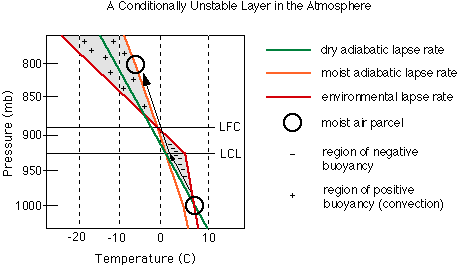
In our previous discussions, to determine stability, we compared the environmental lapse rate to either the dry or the saturated adiabatic lapse rates, whichever was appropriate to the layer in question. To determine if the atmosphere is conditionally unstable, we compare the lapse rate of a parcel to the environment as it passes through the LCL. The atmosphere is described as conditionally unstable if the environmental lapse rate is less than the dry adiabatic lapse rate beneath the LCL and greater than the saturated adiabatic lapse above the LCL. So, conditional instability can be easily determined by making a comparison of all three lapse rates.
By the description above, in a conditionally unstable atmosphere, a parcel is first lifted through a stable layer, where it is colder than the surrounding air, up to a point where the atmosphere is unstable. There, its temperature is warmer than the environment. The point between the stable and unstable regions, where the parcel temperature and the environmental temperature are equal, is called the level of free convection (LFC). It is called the level of free convection because above this point the parcel will rise on its own. Below is a graphical illustration of a conditionally unstable atmosphere.
In the diagram above, we lifted our moist parcel from 1000 mb (100.0 kPa) up through a stable layer to the level of free convection (LFC) which marks the base of the unstable layer. Note that the shaded regions are labeled with "+" or "-" to indicate regions of positive and negative buoyancy. Below the LFC the temperature of the parcel is colder than the surrounding air. This region is stable, while above the LFC, the temperature of the parcel is warmer than the environment. The atmosphere is unstable above the LFC, and the parcel will continue to rise on its own by free convection.
Conditionally unstable layers can persist indefinitely if there is not sufficient lifting of the air near the surface to the level of free convection. For example, nearly the entire tropic region is conditionally unstable up to a height of about 15 km, but in only a few tropical locations is there sufficient lifting to cause deep convection.
 The Shodor
Education Foundation, Inc.
The Shodor
Education Foundation, Inc.